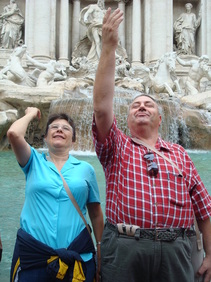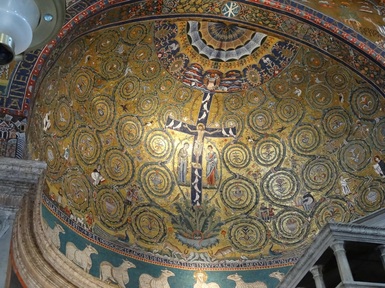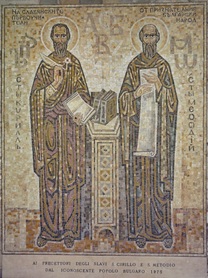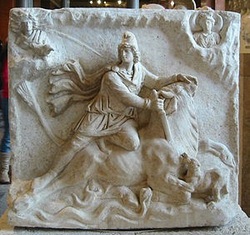



To see all the pics of Rome, some of which were taken on Jeff's new Sony Cyber-shot DSC-HX30V camera, which includes GPS tracking of our shots, click here!
 "We'll return to Rome!" On the morning of September 4th, the Bulgarian clan descended upon Rome like Hannibal, with his famed elephants, never could. Petko and Nadia (Neda’s parents) flew in from Bulgaria and Dimitre (Neda’s brother) took the long haul from Boston while we arrived early on the night train from Venice. Our spacious apartment gave us ample space to unwind before beginning a whirlwind tour of Rome’s sites – the Vatican Museum, Sistine Chapel and Saint Peter’s Basilica on one day, the Pantheon, Spanish Steps, Trevi Fountain, and Piazza Navona another, and the ancient Rome of Palatine Hill, the Forum, and the Coliseum on the last day. It was the first time this part of our family had ever visited Western Europe and the first time in our trip of the world that we have been joined by family. Italy is a great place for such a meeting, as the wonderful cuisine and multi-course meals provide time to catch up and enjoy the company. I’ll skip description of the common tourist attractions above because there is already so much information about them available online or in books (though I will pepper in some pictures of them below). But one slightly lesser known attraction turned out to be my favorite and was tremendously fitting to visit with a family of Bulgarians!  The Tree of Life San Clemente Church sits about a half of a kilometer from the Coliseum and at first glance, it appears to be another beautiful 12-13th century building in Rome. Its central nave features a golden fresco of Christ connected to a “Tree of Life”, a winding network of vines that demonstrates the interconnectedness of life. This is the first clue that this church is a bit different from others, as such an explicitly eastern theme rarely occurs in the churches we've seen so far. But the real beauty and intrigue of San Clemente lies beneath it. It is here that a 4th century church has been preserved in the catacombs of the newer church. This original San Clemente church is haunting to walk through as its LCD lit rooms provide just enough light to imagine worshipers here over 1500 years ago.  Cyril and Methodius For us the main attraction lay in one of the side naves of this ancient building. It is here that Saint Cyril is buried. Cyril, along with his brother Methodius, created the foundation of the Bulgarian written language, called Glagolitic. Cyril had been in Rome to argue that the church liturgy should be spoken in Glagolitic so that the natives of the Slavic regions could understand it. This was opposed by the German clergy, who had used Latin in the region to maintain their position. Cyril convinced the pope that Glagolitic should be allowed, but died shortly after. The Pope wouldn’t let him be returned to his home so his brother asked that he be buried at San Clemente church (whose body the brothers had returned to the Vatican just a year earlier from the Black Sea). Cyril’s tomb was surrounded by tablets inscribed with messages from the nations and peoples he had influenced. There were tablets from the Serbians, Ukrainians, Russians, Slovenians, & Croatians. The Bulgarians had sent a beautiful mosaic of the two Saints to sit opposite the tomb, in honor of the language that Cyril and his brother had given written form. Bulgarians hold a special regard for the Cyrillic alphabet, as it was fully refined from the Glagolitic alphabet Cyril and Methodus had created by their students under the sponsorship of Kings Boris and Simeon during the 1st Bulgarian Empire. It was touching to see all the nations that had honored this man who had helped create a common written bond between them. Much like the Christ depicted in the church above, Cyril’s tomb was a testament to interconnection.  Mithras slaying the bull For most visitors to San Clemente, the interesting part of the visit is not just the 2nd church that lies beneath, but the even older archeological area beneath the 2nd church! It is here that archaeologists have discovered the best preserved “mithraea” (underground temple of the religion of Mithraism) in the world. Very popular among Roman soldiers between the 1st and 4th centuries, the Mysteries of Mithras revolved around the story of the God Mithras slaying a wild bull for the God of the Sun. As the bull dies, its blood gives life to the ground around it. Initiates would eat bread and water to represent the body and blood of the bull and the life it gives out of its death. Citied as an early competitor with Christianity, Mithraism shared many of the same rituals before being systematically destroyed by the early Christian Church. That is why many mithraea have been found with Church’s built on top – a symbolic representation of Christian domination over its competitor. With ancient religions lying beneath the foundations of the Bulgarian ancestral language, Rome proved to be a penetrating historical experience for all of us. From there, we would head down to an equally interesting region of Italy – the Bay of Naples, where ruined cities and the ghosts of the past waited.
To see all the pics of Rome, some of which were taken on Jeff's new Sony Cyber-shot DSC-HX30V camera, which includes GPS tracking of our shots, click here!
0 Comments
Leave a Reply. |